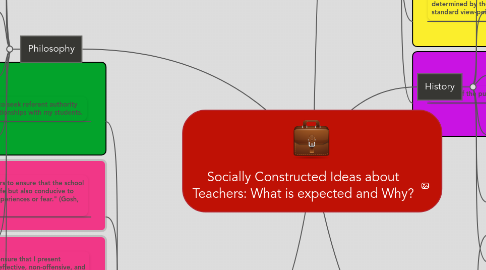
1. Philosophy
1.1. "Educational discourse (language and practice) perpetuates racism in subtle ways." (Ghosh 28).
1.1.1. "The educational system should incorporate multiple perspectives and different ways of knowing and learning." (Gosh, 29)
1.2. Racism is interpreted based on individual perspectives.
1.3. "Teachers have different of ways of coping with racism in the classroom, ranging from ignoring different expressions of racism to dealing with them on an individual basis." (Gosh, 28)
1.4. "Women are often characterized as collaborative, caring, courageous and reflective... women in positions of leadership seek, more often than their male counterparts, relationships that are facilitative of others’ effort rather than solely of their own." (Kruse, Prettyman 453)
1.5. Using technology to enhance the classroom: "As a teaching and learning tool, technology provides the opportunity to stretch my pedagogy and dramatically enhance student learning." (Ewasiuk 14).
1.6. Inclusive education initiatives have changed how teachers need to structure their classes.
1.7. Teaching social justice: How does a teacher integrate social justice into everyday lessons?
1.7.1. Brings into question: What is the purpose of education?
1.7.1.1. "The idea is to encourage kids to become critical analysts of contemporary issues, empathetic defenders of human rights and gatekeepers of the beleaguered Earth." (Reynolds, 2012).
1.8. Students as teachers: Restructuring the classroom.
1.8.1. Encouraging students to think about their learning and having students think through ideas.
2. My Professional Identity
2.1. I will be more likely to seek referent authority and have caring relationships with my students.
2.1.1. As a woman, I will have to be aware of the stereotypes I will face if I want to move into a higher role within the school system. CAN I BE FEMININE AND POWERFUL?
2.2. "It is essential for educators to ensure that the school environment is not only safe but also conducive to learning, free of hurtful experiences or fear." (Gosh, 29)
2.3. As a teacher, I need to ensure that I present knowledge in the most effective, non-offensive, and inclusive way.
2.4. Teaching requires flexibility and the ability to grow with the times.
2.5. Need to take into consideration your students, your parents, your school and your community before deciding what to teach.
2.5.1. How do I teach social justice and open-mindedness without offending anyone?
2.5.1.1. Who do I want my students to become?
2.6. How do I want to structure my classroom: homework, activities, management?
2.7. Is there a fine line between being a good teacher and letting your career consume your life?
3. Sociology
3.1. "While race does not have scientific validity, we must not underestimate its power as a social construct to affect people's lived experiences, their daily lives as well as their futures." (Gosh 27)
3.2. "Power is contingent on the dominance of societal networks and relationships and located in multiple sources." (Kruse. Prettyman 455).
3.3. Canadians like to believe racism does not exist in Canada
3.4. Racism, "is a matter of political power." (Ghosh 27).
3.5. Power is determined based on the balance between women and men.
3.6. Expectations of teachers are growing in today's society
3.6.1. Technology means parents expect to be able to contact a teacher at all times.
3.7. "Appropriate" is typically determined by the majority: standard view-point
3.7.1. Should we be teaching students a mix of perspectives?
3.8. Blurring of the public and private sphere
3.8.1. What is my role as a teacher: vocation vs. career
4. History
4.1. "Non-whites have experienced systemic racism in the Canadian justice system... Violence against Aboriginals has continued from the time of conquest" (Ghosh, 26)
4.2. Women have not typically held positions of power.
4.2.1. Teaching seen as a typically feminine task/chore (Kruse, Prettyman, 456).

